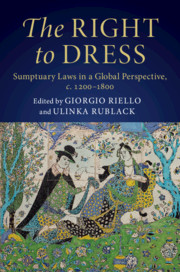(Source: CUP)
Cambridge University
Press is publishing a new book on sumptuary laws.
ABOUT THE BOOK
This is the
first global history of dress regulation and its place in broader debates
around how human life and societies should be visualised and materialised.
Sumptuary laws were a tool on the part of states to regulate not only
manufacturing systems and moral economies via the medium of expenditure and
consumption of clothing but also banquets, festivities and funerals. Leading
scholars on Asian, Latin American, Ottoman and European history shed new light
on how and why items of dress became key aspirational goods across society, how
they were lobbied for and marketed, and whether or not sumptuary laws were
implemented by cities, states and empires to restrict or channel trade and consumption.
Their findings reveal the significance of sumptuary laws in medieval and early
modern societies as a site of contestation between individuals and states and
how dress as an expression of identity developed as a modern 'human right'.
ABOUT THE EDITORS
Giorgio Riello, University of Warwick
Giorgio Riello is Professor of Global History
and Culture at the University of Warwick and Chair of the Pasold Research Fund.
He is the author of four books, including Cotton: The Fabric that Made the
Modern World (Cambridge, 2013) which won the World History Association Book
Prize 2014. In 2016 he received the Iris Foundation Award for his contribution
to the Decorative Arts and Material Culture.
Ulinka Rublack, University of Cambridge
Ulinka Rublack, FBA is Professor of early
modern European history at the University of Cambridge, and is a Fellow of St
John's College. Her previous books include Dressing Up: Cultural Identity in
Early Modern Europe (2011), which won the Bainton Prize. She is co-editor, with
Maria Hayward, of The First Book of Fashion (2015).
TABLE OF CONTENTS
List of
illustrations
List of
figures
List of
maps
List of
tables
List of
contributors
Acknowledgements
The Right
to Dress: The World of Sumptuary Laws, c.1200–1800 Ulinka Rublack and Giorgio
Riello
Part I.
Sumptuary Laws in Medieval and early modern Europe:
1. The
right to dress: sartorial politics in Germany, c.1300–1750 Ulinka Rublack
2. Playing
by the rules? Dressing without sumptuary laws in the low countries from the
fourteenth to the eighteenth century Isis Sturtewagen and Bruno Blondé
3.
'Outlandish superfluities': luxury and clothing in Scottish and English
sumptuary law, fourteenth to the seventeenth century Maria Hayward
4.
Regulating sumptuousness: changing configurations of morals, politics, and
economics in Swiss cities in the seventeenth and eighteenth centuries André
Holenstein
5.
Dangerous fashion in Swedish sumptuary law Eva I. Andersson
Part II.
Enacting Sumptuary Laws in Italy:
6.
Sumptuary laws in Italy financial resource and instrument of rule Maria
Giuseppina Muzzarelli
7.
Defending the right to dress: two sumptuary law protests in sixteenth-century
Milan Catherine Kovesi
8. Against
the sumptuary regime: sumptuary prosecutions in sixteenth- and
seventeenth-century Padova Luca Molà and Giorgio Riello
Part III.
The European Maritime Powers and their Empires:
9. Luxury,
novelty, and nationality: sumptuary legislation in Late Medieval and Early
Modern Spain Amanda Wunder
10.
Sumptuary laws in Portugal and its empire from the fourteenth to the eighteenth
century Francisco Bethencourt
11.
'Splendour and magnificence': diplomacy and sumptuary codes in Early Modern
Batavia Adam Clulow
12. Race,
clothing and identity: sumptuary laws in colonial Spanish America Rebecca Earle
13.
Sartorial sorting in the colonial Caribbean and North America Robert DuPlessis
Part IV.
Early Modern World Empires:
14.
'Grandeur and show': clothing, commerce, and the Capital in early modern Russia
Matthew P. Romaniello
15. Women,
minorities, and the changing politics of dress in the Ottoman Empire, 1650–1830
Madeline Zilfi
16. Wearing
the hat of loyalty: imperial power and dress reform in Ming Dynasty China BuYun
Chen
17.
Regulating excess: the cultural politics of consumption in Tokugawa Japan
Katsuya Hirano
18.
Sumptuary laws in precolonial West Africa: the examples of Benin and Dahomey
Toby Green
Select
bibliography
Index.
More
information here


No comments:
Post a Comment